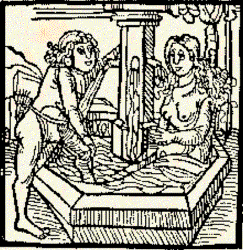Shakespeare's marriage: speculation . . .
While the discrepancies between the marriage license and the bond have raised questions, Shakespeare's wife, Anne Hathaway*, was a woman eight years his senior; at the time of their marriage, she would have been 26 years old and he 18*.
The existence of two Annes on the records has given rise to speculation about Shakespeare's romantic life. Anne Whateley was probably the creation of a careless clerk; but perhaps Shakespeare was caught in a lovers' triangle*. The early birth of their first daughter could mean that Shakespeare was forced* to marry Anne Hathaway; however it is also possible that the couple had previously been joined by pledge or in a "handfast" marriage*. Although their licence exempted them from the traditional three readings of the banns, such requests were not uncommon.
In As You Like It, Shakespeare writes of springtime and country lovers--as he himself may have been. The music is by Thomas Morley.
It was a lover and his lass,
With a hey, and a ho, and a hey nonino,
That o'er the green cornfield did pass
In springtime, the only pretty ringtime,
When birds do sing, hey ding a ding, ding,
Sweet lovers love the spring.
Between the acres of the rye,
With a hey, and a ho, and a hey nonino,
These pretty country folks would lie
In springtime, etc.
This carol they began that hour,
With a hey, and a ho, and a hey nonino,
How that a life was but a flower
In springtime, etc.
And therefore take the present time,
With a hey, and a ho, and a hey nonino,
For love is crowned with the prime
In springtime, etc.
Footnotes
-
Anne Hathaway as wife
The apparent confusion of Annes -- Whately and Hathaway -- mentioned in the marriage licences is cleared up by a request in a will of Thomas Whittington, the Hathaways' shepherd. Whittington left 40 shillings to the poor people of Stratford, and asked that the money be paid by "Anne Shaxspere, wyf unto Mr. Wyllyam Shaxspere." It is clear that whoever Anne Whately might have been, Anne Hathaway was Shakespeare's wife. (David Kathman)
-
Age of the partners in marriage
Duke Orsino to "Cesario" (Viola):
Let still the woman take
An elder than herself; so wears she to him,
So sways she level in her husband's heart;
For, boy, however we do praise ourselves,
Our fancies are more giddy and unfirm,
More longing, wavering, sooner lost and worn,
Than women's are.
(Twelfth Night, 2. 4. 29-35)
A young man married is a man that's marred
(All's Well That Ends Well, 2. 3. 315) -
Triangles: a Renaissance soap opera?
For example, perhaps Shakespeare learned that he had got Anne Hathaway pregnant, so ran off to Shottery (where the licence was issued) to marry his true love, Anne Whately (he liked the name Anne). The two farmers presumably carted him off to marry Anne Hathaway and preserve her reputation.
-
The trials of forced marriages
Prospero admonishes Ferdinand, and warns against premarital sex:
If thou dost break her [Miranda's] virgin-knot before
All sanctimonious ceremonies may
With full and holy rite be minist'red,
No sweet aspersion shall the heavens let fall
To make this contract grow; but barren hate,
Sour-eyed disdain, and discord shall bestrew
The union of your bed with weeds so loathly
That you shall hate it both.
(The Tempest, 4. 1. 15-22) -
The "bed-trick" and troth plight
Handfasting, or troth plight, was a contract to marry, conducted before witnesses and marked by a kiss and the presentation of a ring. If followed by sexual intercourse, it formed a binding marriage; children born between the betrothal and an actual wedding ceremony were usually considered legitimate. Sex before marriage may even have been encouraged to determine the fertility of a potential bride.
In Measure for Measure, Claudio and Julietta have been through some such ceremony, though it is not enough for the strict Angelo:
. . . upon a true contract
I got possession of Julietta's bed.
You know the lady, she is fast my wife,
Save that we do the denunciation lack
Of outward order.
(1. 2. 148-52)Ironically, Angelo and Mariana have apparently undertaken the first stage in the same process, and the "bed-trick" later in the play may have been less distasteful to the Elizabethans than it has been to later critics.
